
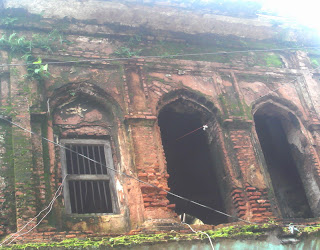
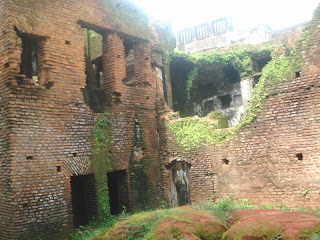

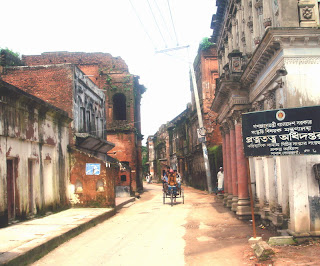

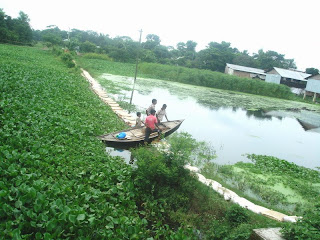
Innovative bridge by sand bags and crossing of boat

Panam bridge of Mughal era restored
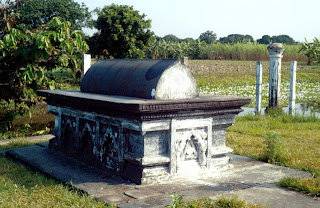
Tomb of Sultan Ghiyasuddin Azam Shah, the third Iliyas Shahi ruler of Bengal who died in 1411 A.D. at Mograpara, Sonargaon.

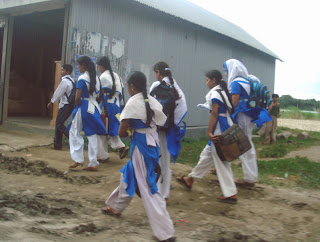
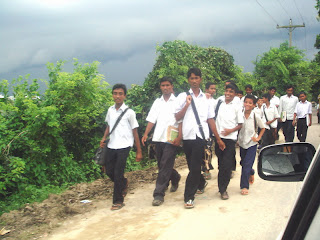
"Neel Nobo-ghoney Ashaar Gogoney Teel Thai aar Nahirey.."

Picnic spot at Mograpara
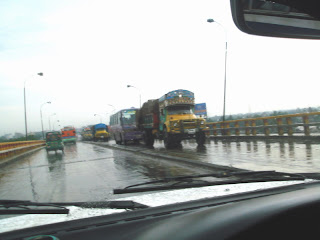
view of Dhaka-Chittagong highway after rain
Sonargaon emerged as the capital of an independent Sultanate under Fakhruddin Mubarak Shah in 1338 AD. During Muslim rule it became the capital of East Bengal. In Mahuan's writings, a splendid and vivid description of this vibrant township can be found. The great Muslim traveler Ibn Battuta visited Sonargaon in the 14th century. Later in 1585 the famous traveler Ralph Fitch visited Sonargaon to elaborately tales of the finest cotton fabric- Muslin which Sonargaon was famous and the mighty reign of Isa Khan, one of the most powerful of the Baro-Bhuiyans. From that time down to the coming of the Mughals, it was a provincial metropolis, except for a period when it became a capital city under the house of Isa khan Masnad-i-Ala. After Isa Khan’s death it became a part of the great Mughal Empire of Akbar.
With the establishment of the Mughal capital of Subeh Bangala at Dhaka in the year 1608/1610 AD, Sonargaon lost its importance. In 1858 all the territories held by the East India Company (including Dhaka) were brought under British rule. Once a thriving port and commercial centre of Sonargaon, only the ruins of the ancient city remain scattered; the area is buried in a dense jungle of bamboos and other trees.
In the late nineteenth and early twentieth century, Panam or Painam area of medieval Sonargaon grew up as a by-product of the commercial activities of the English East India Company. Panam nagar stretched in a single street 5 m wide on the average and 600 m in length. All the buildings have the character of urban street front houses and are lined up on either side of this street. 52 houses exist in dilapidated and disused condition. Panam appears to be well protected by artificial canals all around (ref: banglapedia).
Panam village became prominent during British colonial period as cloth trading centre. Dutch, French and Armenians settled down even earlier. The French influence is still visible in the merchant houses that line the main street of Panam. The cloth merchants came from places of India such as Calcutta, Patna and Bombay. The upper-middle class Hindu merchants in 19th century, titled 'Sahas' and 'Poddars'. The residences built by them blending the indo-European architectural styles reflect the socio-economic condition and lifestyle of the merchants and the elite class in the British colonial period. The buildings with or without courtyards expose the hybrid nature that evolved the blend of Mughal, Colonial and Hindu architectural elements and motifs.
One feature about early colonial architectural style was that a majority of the constructions of British India were anonymous. English bricklayers had made an early appearance in the Presidency towns (comprising Bengal, Madras and Bombay) and the East India Company also had its own resident architects. Yet, from the beginning to the culmination of the British Empire, only a handful of eminent practitioners ever designed a building for the Raj. The stones of this empire were mostly put together by amateurs, by soldiers who had learnt the building trade during their military education in England, or in later years by employees of the Public Works Department, established in 1854. They relied upon handbook of architects popular in the 18th and 19 century.
The merchants lived a vibrant life in Panam and Dhaka until the first quarter of 20th century. With Calcutta developed into capital of British raj and transfer of most commercial activities over there, majority of the elites of Panam left. With there departure the whole village was nearly abandoned.
Also see, Heritage: Sonargaon to Panam Nagar!















keep it up!
ReplyDeleteAssalaamu Alaikum Uncle,
ReplyDeleteI hope you are doing well insha'Allah.
As always, very interesting pictures! I take it the pictures of those old structures in Panam-nagar date from the Mughal period? I love the arches and the brick-work.
Thank you so much for sharing your insightful images with the world. All the very best regards,
nadia
Visited your blog after a month or two. Enjoyed all the pictures of the past and present. Googled the history of 'Urdu Road'. Interesting.
ReplyDeletecan somebody tell me when was "Panam Nagar" first discovered? is it in the mid-nineteenth century or something.
ReplyDeleteVery very best sharing i could imagine
ReplyDeleteদেশের নিজস্ব পরিচয় কীর্তি ও জাতির শিকড় সম্পৃক্ত বিশিষ্টতা। প্রতিটি দেশের নিজস্ব পরিচয় কীর্তি ও বিশিষ্টতা থাকে, যা জাতির শিকড় স্পর্শ করে। ঐতিহ্যের বিষয়টিও তেমনি।
ReplyDeleteগর্বের সোনারগাঁও- এর পানাম নগরীর। দখলদারদের ক্রমবর্ধমান আগ্রাসন আর আমাদের দায়িত্বের অবহেলায় এই গর্ব আজ হুমকির সম্মুখিন।
ছবিগুলো সোনারগাঁর বিখ্যাত পোদ্দার বাড়ির। বর্তমানে এটি একজন ব্যক্তি ক্রয়কৃত সম্পত্তি বলে দাবি করছেন। বছর খানি আগে চালু করেন রাবার কারখানা। তবে বর্তমানে তা বন্ধ আছে।
এই ঐতিহ্য আমাদের কাছে আমাদের পূর্বপুরুষের আমানত ভবিষ্যত প্রজন্মের জন্য। কারও সম্পত্তি বা কর্তৃত্বের খোরাক নয়।
নিজেস্ব সম্পত্তি দাবি করে স্থানীয় জনপ্রতিনিধিসহ অনেকে প্রভাবশালীরা তাদের দখলদারিত্ব বজায় রাখার জন্য, এমন দোকান কিংবা দালানের আকারআকৃতি পরিবর্তন করছেন ।
স্থানীয়দের সঙ্গে কথা বলে এবং সরজমিনে গিয়ে দেখা যায় খুব কাছেই পৌরভবন। কিন্তু পৌর পিতাও স্বয়ং ব্যস্ত তার দখলদারীত্ব প্রমাণে। এখানে কিছু ভবনের তিনিও দাবিদার । তাই অস্থায়ী লোকজন রেখে দখল প্রমাণ রাখছেন।
ঐতিহাসিক এই সম্পদের কোন মূল্য আমরা এখনো অনুধাবন করতে পারিনি। প্রতিটি উপজেলার চেয়ারম্যানের জন্য কেনা হচ্ছে নতুন নতুন গাড়ি । মন্ত্রীর তার শখ মিটানোর জন্য কিনছেন কোটি টাকা দামের নতুন মডেলের গাড়ি। আর টাকার অভাব এই অজুহাতে বিলীন হচ্ছে আমাদের গর্ব ................
সংবিধানের ২৪ অনুচ্ছেদের পুরাকীর্তি রক্ষার দায়িত্ব রাষ্ট্রর জন্য বাধ্যতামূলক করা হয়েছে। উপরের ছবিগুলো আমাদের আটশ বছরের ঐতিহ্যের বর্তমান চিত্র। দেশে নানা রকম থিমপার্ক এবং বিনোদনকেন্দ্র করা হচ্ছে, অন্যদিকে অনাদর আর অবহেলায় অজস্র পুরাকীর্তি ও অনেক ঐতিহ্য বিলীন হচ্ছে।
বড্ড দেরি হয়ে যাচ্ছে, আমাদের সকলের এই সম্পদ রক্ষায় এগিয়ে আসা প্রয়োজন।
http://www.somewhereinblog.net/blog/shovan1209/28932100
syed saiful alam
shovan1209(at)yahoo.com
On the left side bottom of the photo marked Indian Museum #816, there is an image of elephant walking. That is very interesting.
ReplyDelete